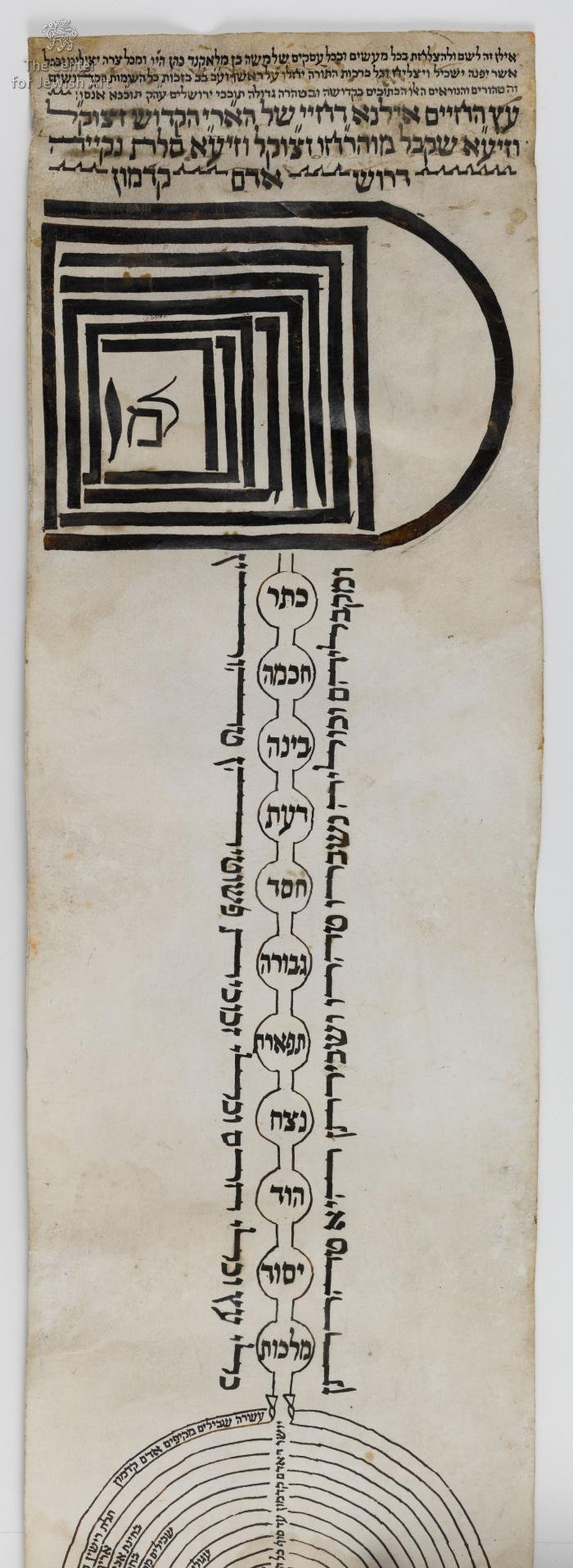
The following description was prepared by William Gross:
Kabbalistic diagrams resembling Porphyrian trees have been known at least since the sixteenth century as “Ilanot” [Heb. pl. Arborae; sing. "Ilan"]. [First such reference known to me is in the work of Guillaume Postel, who refers to "Ilanoth" as a genre of rabbinic literature.] Ilanot constitute visual representations of kabbalistic cosmologies from the relatively simpler forms of the thirteenth century to the far more complex and ramified systems in Lurianic Kabbalah from the sixteenth century onward. The increasing complexity of cosmic trees between the thirteenth and eighteenth centuries directly reflects the exponential ramification of kabbalistic theosophy that took place over those centuries. Given the overwhelmingly visio-spacial conceptions of the divine in its evolutionary “becoming” in these mystical traditions, Ilanot could serve as cosmic maps. This divine cartography aspired to capture the synchronic interrelations between the various facets of the godhead and creation as well as their diachronic, evolving emergence.
This Ilan is a fine early copy of the Ilan originally drafted by Isaac Kopio and one of the most widely reproduced kabbalistic divinity maps. Kopio ( late 17th-early 18th c.) was a Lurianic kabbalist who traveled extensively throughout his native North Africa, as well as Italy and the Ottoman Empire. His Ilan is the most outstanding expression of the transfer of European Kabbalah to North Africa, and his is the only Ilan known to have been fashioned there. At the top of the scroll is a striking figure, already present in, the earliest kabbalistic manuscripts of the fourteenth century. The image is of the first letters of each of the ten Se# rot nested within each other. The khaf of Keter is outermost, and the mem of Malkhut is at the center. Next are diagrammatic representations of the Divine Faces (Parzufim) that show the clear influence of the European scrolls associated with Meir Poppers.
What’s an Ilan? Any synoptic diagrammatic presentation of kabbalistic cosmology. The basic graphical forms could range from the arboreal to the boldly anthropomorphic. Lurianic Ilanot, in their lengthy and complex presentations, often feature both, as well as spreadsheet-like tables. The iconic decadal tree is an Ilan, as is the intricately Baroque Hammerschlag Ilan. Diagrams expressing particular concepts within a larger framework, such as the illustrations that frequently accompany certain cosmogonic discussions in the Lurianic corpus, would doubtfully have been called ilanot by anyone. However simple or complex the pictorial-diagrammatic features of an Ilan, extensive textual material is frequently embedded in and around the geometrical forms. The texts may be paraphrastic chapter headings, original compositions, or the study notes of a student. Their connection to the pictorial features alongside which they appear is usually clear, with the text providing a verbal key to the quality or process depicted graphically. That said, in complex Ilanot, simple keying gives way to more complex and even inscrutable connections. Indeed, these manuscripts demand to be treated as “integrated systems of communication” that raise “questions about how verbal and visual patterns of meaning were constructed, combined, and modified.”
Even though this Ilan is a relatively large sign, the beginning text identifies that it was written as an amulet. It therefore serves as a transition document between the Ilanot written for study and those that were done as amuletic parchments only. This example was written in Morocco, taken to Buchara and with the Aliyah of the Jews from Buchara returned to Eretz Israel with an immigrant in the 1980's. It is written on goat skin on four sections.



